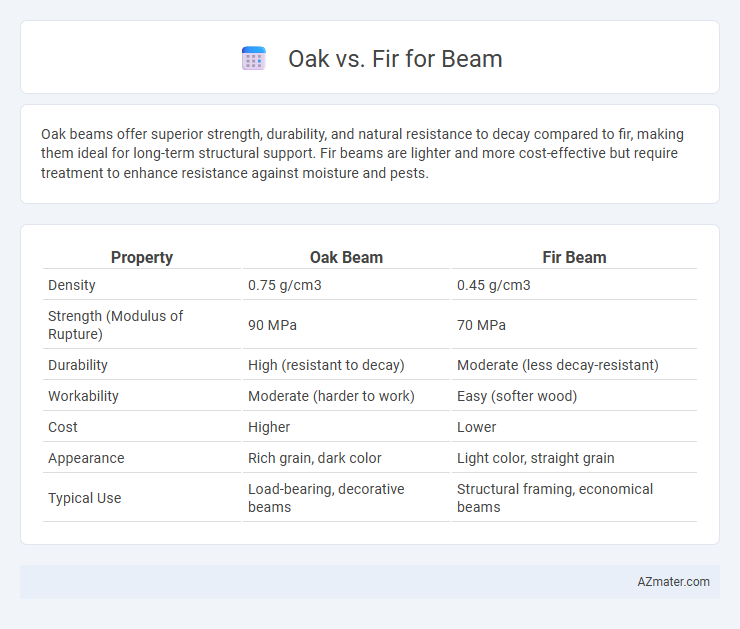Oak beams offer superior strength, durability, and natural resistance to decay compared to fir, making them ideal for long-term structural support. Fir beams are lighter and more cost-effective but require treatment to enhance resistance against moisture and pests.
Table of Comparison
| Property | Oak Beam | Fir Beam |
|---|---|---|
| Density | 0.75 g/cm3 | 0.45 g/cm3 |
| Strength (Modulus of Rupture) | 90 MPa | 70 MPa |
| Durability | High (resistant to decay) | Moderate (less decay-resistant) |
| Workability | Moderate (harder to work) | Easy (softer wood) |
| Cost | Higher | Lower |
| Appearance | Rich grain, dark color | Light color, straight grain |
| Typical Use | Load-bearing, decorative beams | Structural framing, economical beams |
Introduction to Oak and Fir Beams
Oak beams are renowned for their exceptional strength, density, and durability, making them ideal for structural support in heavy-load applications. Fir beams, while lighter and more flexible, offer excellent stability and resistance to warping, commonly used in residential framing and interior construction. Both woods provide unique benefits, with oak favored for longevity and robustness, and fir selected for cost-effectiveness and ease of handling in beam construction.
Oak vs Fir: Key Characteristics
Oak beams are prized for their exceptional strength, hardness, and durability, making them ideal for load-bearing structures and long-lasting frameworks. Fir beams offer a lighter weight alternative with good dimensional stability and moderate strength, commonly used in construction where ease of handling is essential. Oak's dense grain and resistance to wear contrast with fir's straight grain and better resistance to warping, influencing their selection based on project requirements.
Strength and Durability Comparison
Oak beams exhibit superior strength and durability compared to fir, making them ideal for structural applications requiring long-term load-bearing capacity. Oak's dense grain structure provides enhanced resistance to wear, decay, and insect damage, resulting in a longer lifespan for beams in both indoor and outdoor settings. Fir beams, while lighter and easier to work with, typically have lower hardness and are more prone to dents and moisture-related degradation.
Appearance and Aesthetic Differences
Oak beams showcase a rich, prominent grain pattern with warm golden to reddish-brown tones that enhance rustic and traditional aesthetics. Fir beams exhibit a more uniform, straight grain with lighter, creamy to reddish hues, lending a clean, modern, and minimalist appeal. The dense, coarse texture of oak contrasts with fir's smoother, softer surface, influencing the tactile and visual impact in architectural design.
Cost and Budget Considerations
Oak beams typically cost more than fir due to their density, durability, and aesthetic appeal, making them a premium choice for structural projects with higher budgets. Fir beams offer a more budget-friendly option, providing sufficient strength and lighter weight ideal for cost-conscious constructions without significant compromise in performance. Selecting between oak and fir hinges on balancing initial investment with long-term value, where oak adds lasting durability and fir maximizes upfront cost savings.
Workability and Installation
Oak beams offer exceptional durability and strength but can be more challenging to work with due to their hardness and density, requiring specialized tools for cutting and shaping. Fir beams are easier to handle and install because of their softer texture and lighter weight, allowing for quicker adjustments on-site and smoother fastening. In terms of installation efficiency, fir's workability often translates to reduced labor time and overall project cost compared to oak.
Environmental Impact and Sustainability
Oak beams have a higher environmental impact due to their slower growth rate and denser wood, requiring more extended forest harvesting cycles. Fir beams are considered more sustainable as fir trees grow faster and can be sourced from well-managed, renewable forests, reducing deforestation risks. Both species offer durable structural integrity, but fir's lower carbon footprint and quicker regeneration make it a preferred choice for eco-conscious construction.
Common Applications in Construction
Oak beams are favored in construction for their exceptional durability and strength, making them ideal for load-bearing structures such as floor joists and support frameworks. Fir beams, characterized by their straight grain and lighter weight, are commonly used in framing, roof trusses, and interior finishing where ease of handling and cost-effectiveness are priorities. Both woods are selected based on structural requirements and aesthetic preferences, with oak providing superior hardness and longevity, while fir offers versatility and quicker installation.
Maintenance and Longevity
Oak beams offer superior longevity due to their high density and natural resistance to decay, requiring minimal maintenance over time. Fir beams, while more affordable and easier to work with, demand regular treatment and inspections to prevent moisture damage and insect infestation. Choosing oak for structural beams maximizes durability and reduces long-term upkeep costs compared to fir.
Choosing the Right Wood for Your Project
Oak offers exceptional strength and durability, making it ideal for structural beams requiring high load-bearing capacity and resistance to warping. Fir, while lighter and more cost-effective, provides good stability and ease of handling, suitable for projects with moderate weight demands and quicker installation. Selecting between oak and fir depends on factors such as budget, load requirements, environmental conditions, and desired longevity for your beam structure.

Infographic: Oak vs Fir for Beam
 azmater.com
azmater.com